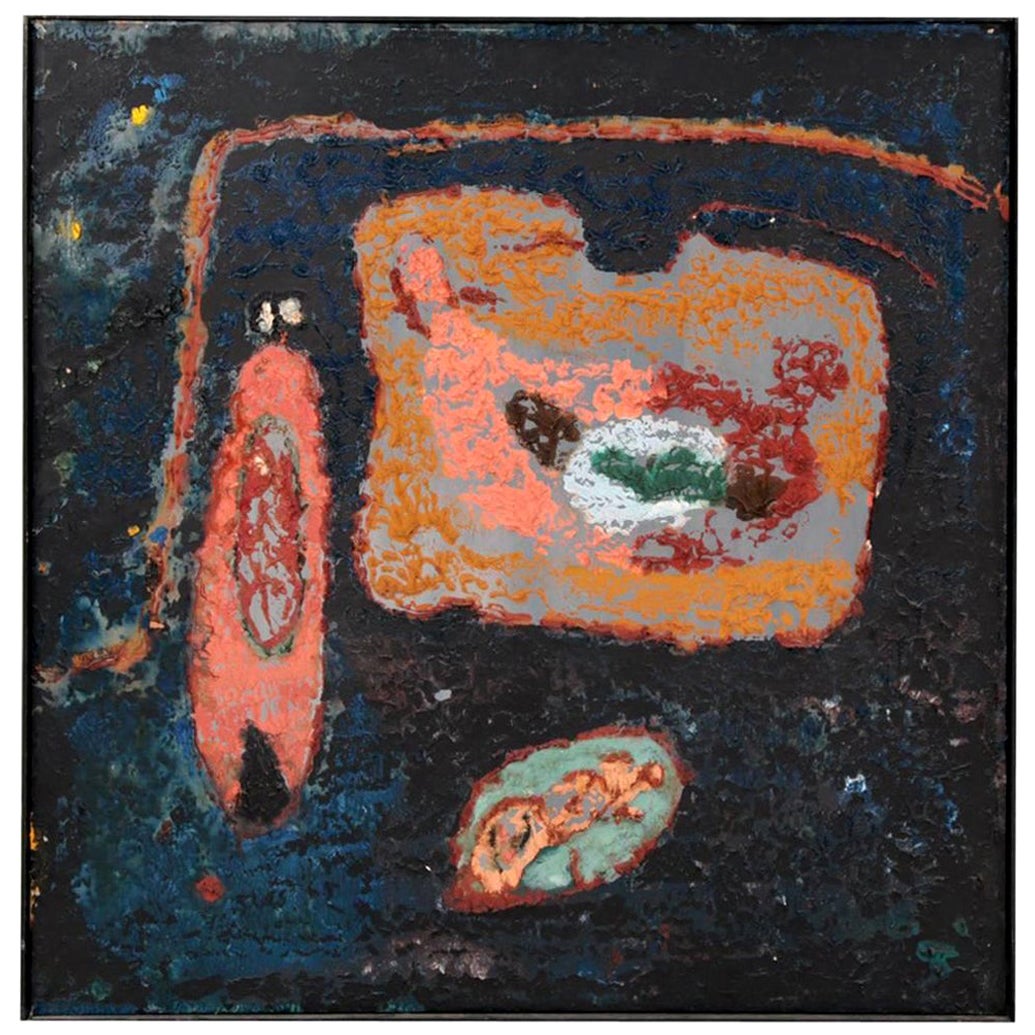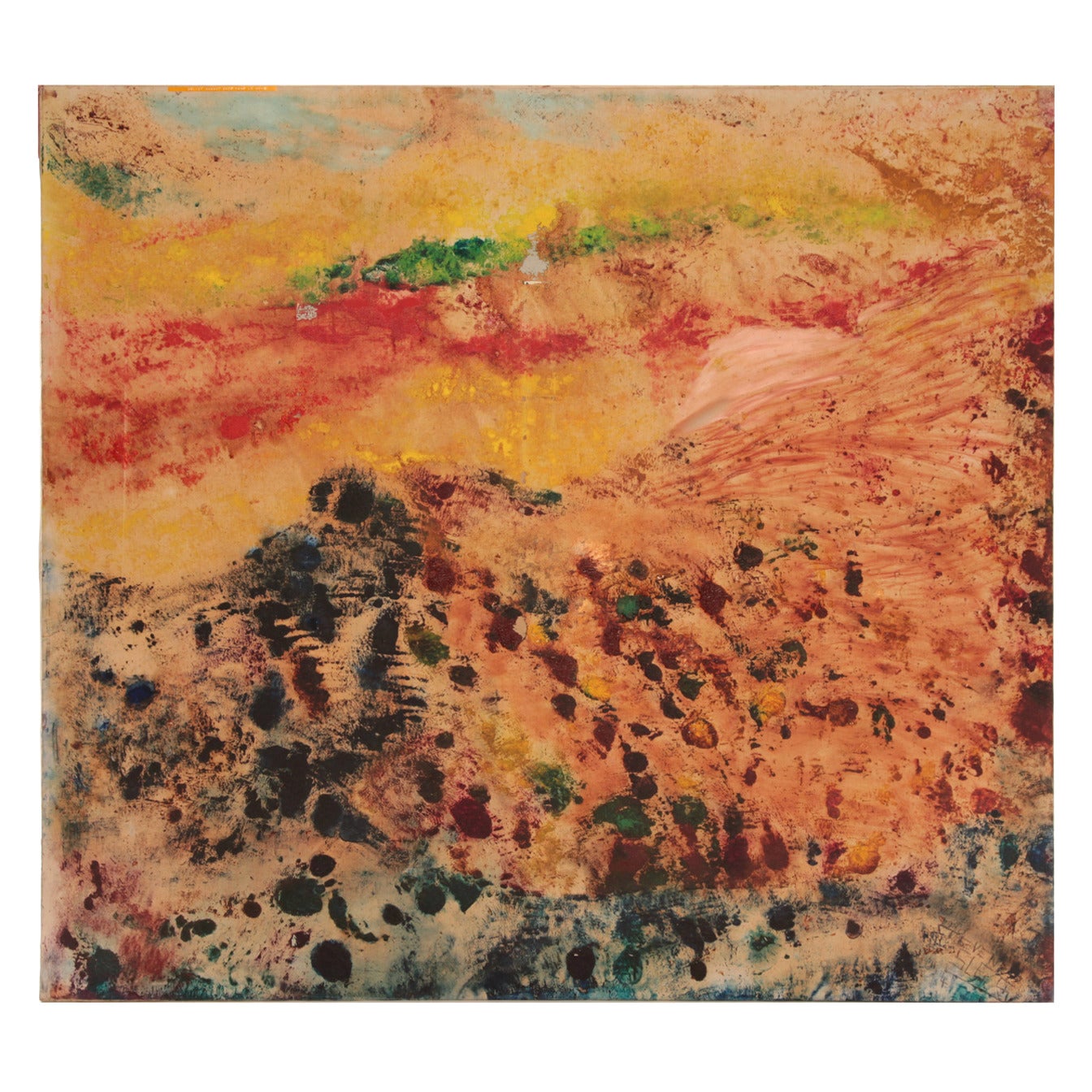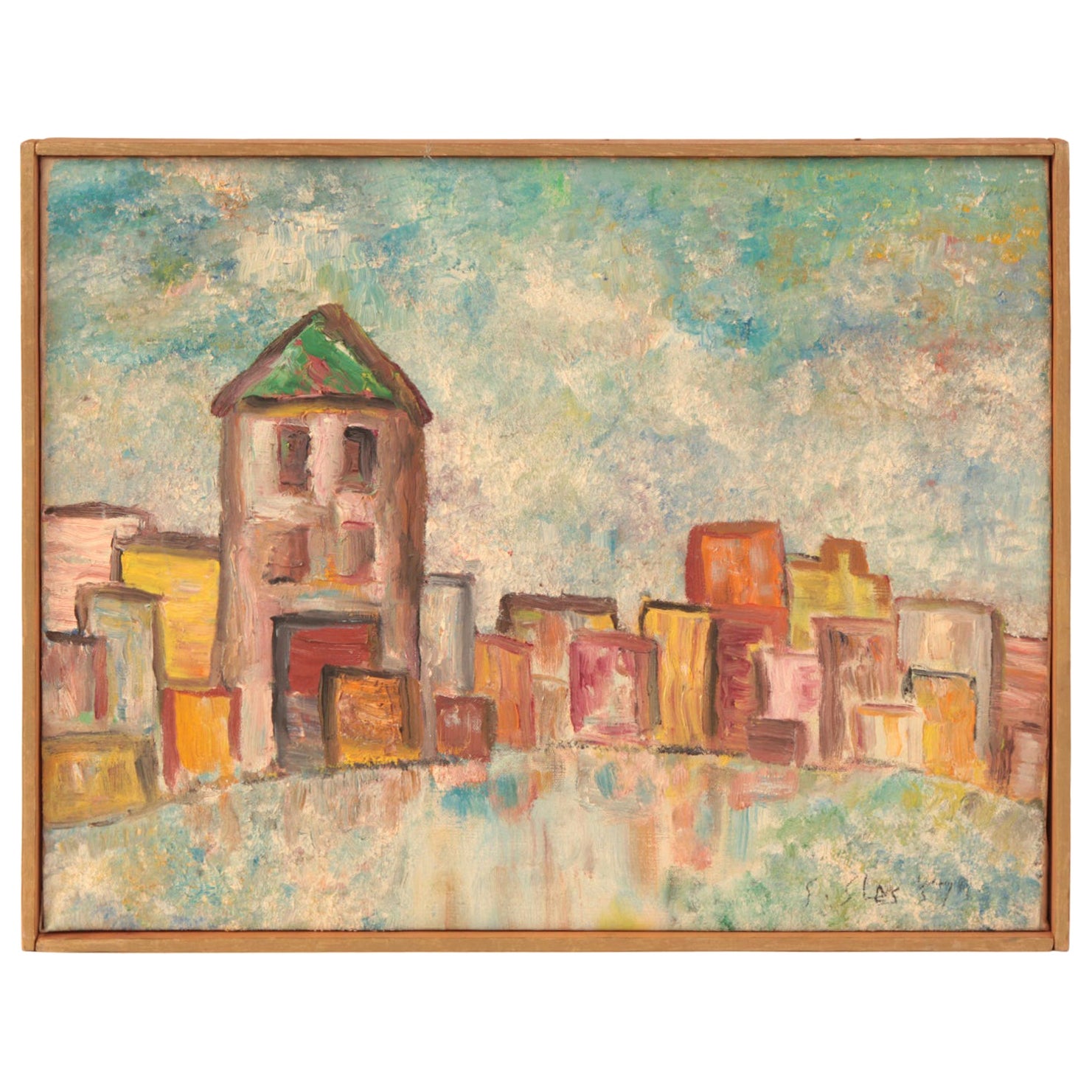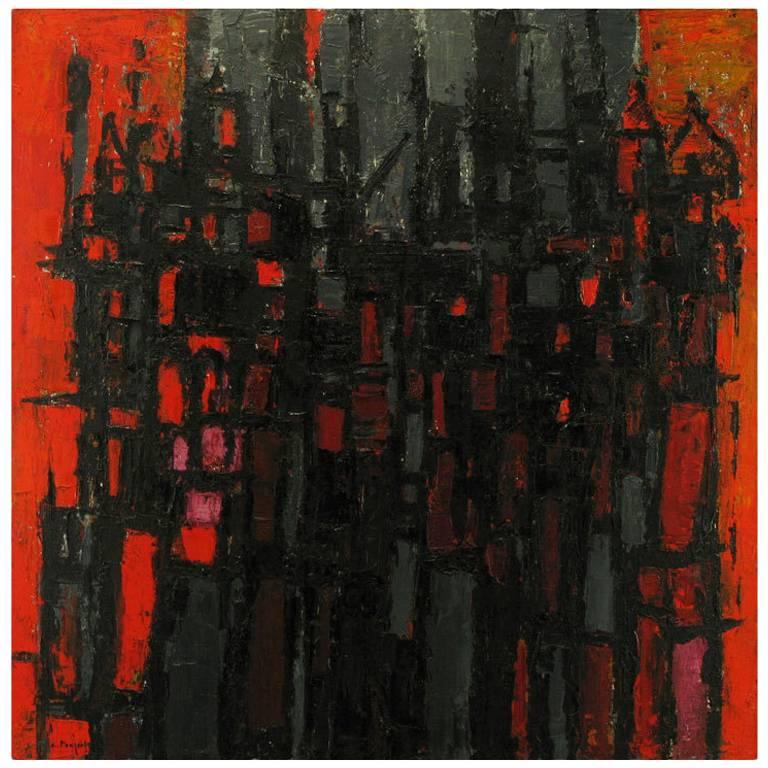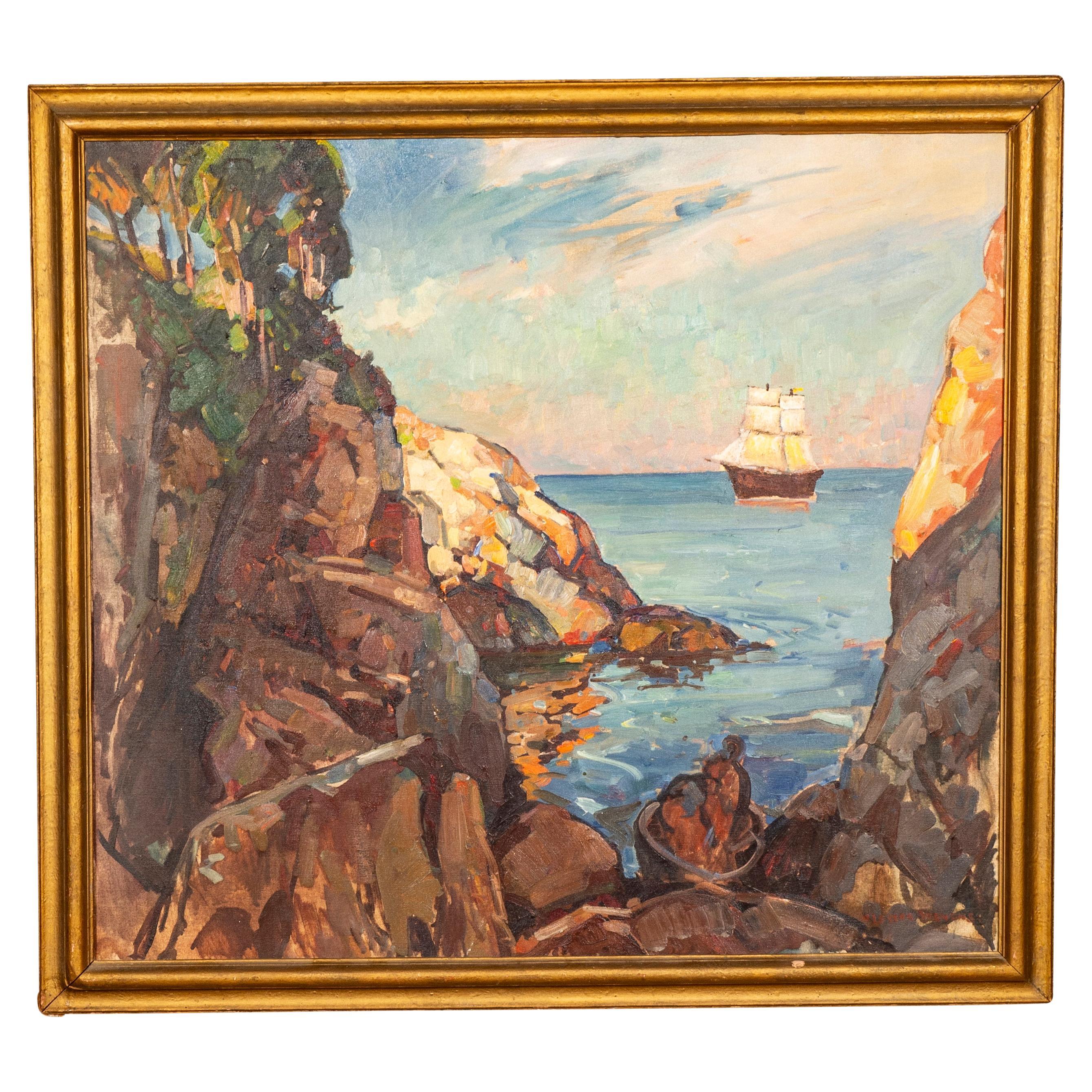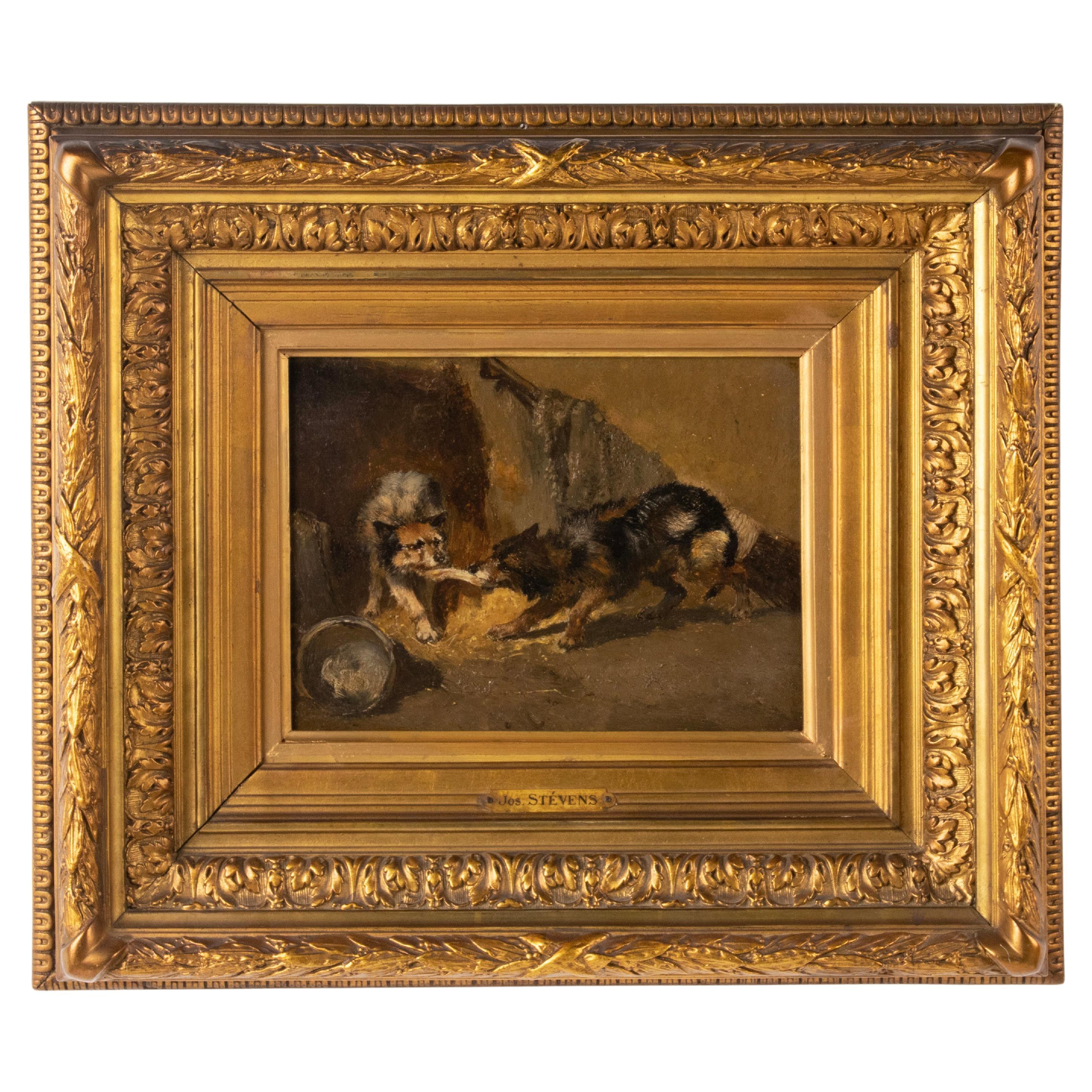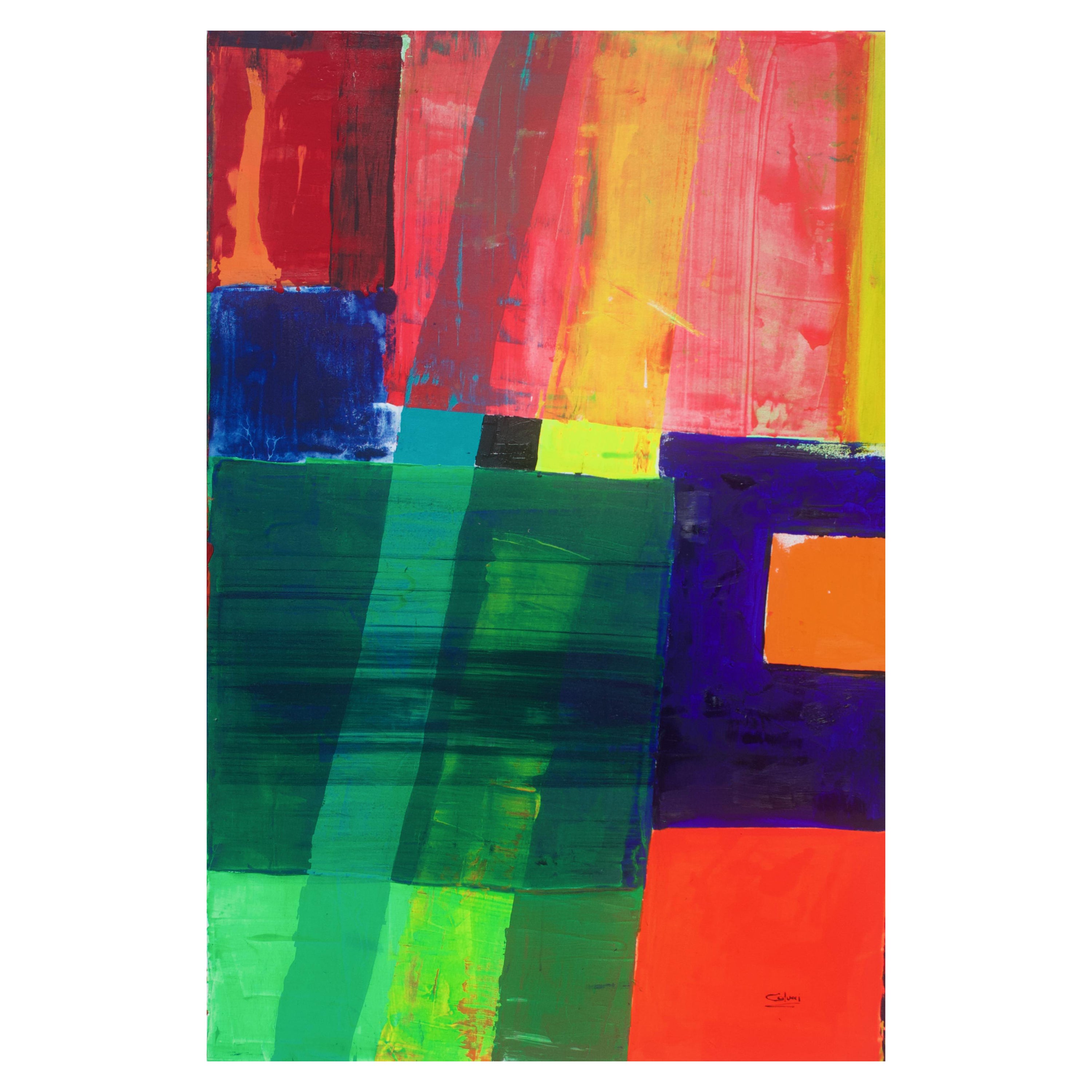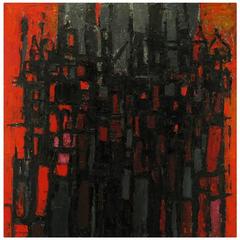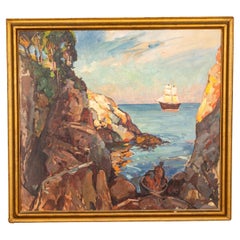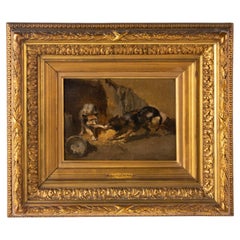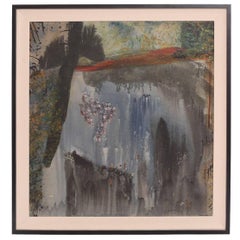
Richly Layered and Vibrant Oil Painting by Steven Sles
View Similar Items
Want more images or videos?
Request additional images or videos from the seller
1 of 6
Richly Layered and Vibrant Oil Painting by Steven Sles
About the Item
- Creator:Steven Sles (Artist)
- Dimensions:Height: 32.63 in (82.89 cm)Width: 30.63 in (77.81 cm)Depth: 2.25 in (5.72 cm)
- Style:Mid-Century Modern (Of the Period)
- Place of Origin:
- Period:
- Date of Manufacture:Early 1960s
- Condition:
- Seller Location:Phoenix, AZ
- Reference Number:1stDibs: LU85324815123
About the Seller
5.0
Gold Seller
These expertly vetted sellers are highly rated and consistently exceed customer expectations.
Established in 1993
1stDibs seller since 2008
410 sales on 1stDibs
Associations
20th Century Specialists
More From This SellerView All
- Steven Sles 1960's Textured Abstract Oil PaintingBy Steven SlesLocated in Phoenix, AZTextured oil on linen painting by Steven Sles, circa early 1960s. Sles was handicapped and used his mouth to paint. He studied under Hans Hoffman. This ex...Category
Vintage 1960s American Mid-Century Modern Paintings
MaterialsPaint
- Oil Painting Ocean Scene on Linen by Steven SlesBy Steven SlesLocated in Phoenix, AZEarly Steven Sles oil on linen painting circa 1955. Due to his Cerebral Palsy, Sles used his mouth to paint his works and studied under Hans Hoffman. This work mixes thick texture an...Category
Vintage 1950s American Mid-Century Modern Paintings
MaterialsLinen
- Abstract Steven Sles Midcentury Oil Painting on LinenBy Steven SlesLocated in Phoenix, AZEarly Steven Sles oil on linen painting circa 1964. Sles was a mouth painter with very limited use of his hands. He was also a student of Hans Hoffman. This example has a wonderful l...Category
Vintage 1960s American Mid-Century Modern Paintings
MaterialsLinen
- Steven Sles City Landscape Oil on Linen Painting, 1957By Steven SlesLocated in Phoenix, AZEarly oil on linen landscape painting depicting a city by Steven Sles circa 1957. This example has a thick textured background and foreground with architectural and natural forms in ...Category
Vintage 1950s American Mid-Century Modern Paintings
MaterialsLinen
- Leonardo Nierman 1963 Abstract Oil PaintingBy Leonardo NiermanLocated in Phoenix, AZLeonardo Nierman Mendelejis (1 November 1932 – 7 June 2023) was a Mexican painter and sculptor with a background in music. His musical training had a deep influence on his artwork, w...Category
Vintage 1960s Mexican Mid-Century Modern Paintings
MaterialsPaint
- Dick Sutphen Abstract Sunset Oil Painting, 1968Located in Phoenix, AZDick Sutphen oil painting, circa 1968. Beautiful flow of color and movement.Category
Vintage 1960s American Mid-Century Modern Paintings
MaterialsPaint
You May Also Like
- Constantine Pougialis, Large and Vibrant Abstract Oil PaintingBy Constantine PougialisLocated in Chicago, ILLarge and vibrantly colored in orange, red, fuschia, gray and black, abstract expressionistic oil on canvas by listed Greek-American artist, Constantine Pougialis. Constantine Pougia...Category
Vintage 1960s American Paintings
MaterialsCanvas, Giltwood
- Large Oil On Canvas Painting By William Lester StevensLocated in Essex, MALarge seascape with cove and ship. Either Gloucester Mass or coastal Maine. Well rendered and showing a rocky cove with trees ,ocean etc. Lester Stevens 1888-1969 is a well noted Am...Category
Vintage 1930s American Paintings
MaterialsCanvas, Wood
- Mid 19th Century Oil Painting Dogs by Joseph StevensBy Joseph StevensLocated in Casteren, Noord-BrabantAn oil painting of two rustic dogs fighting over a piece of food. It is painted on an oak panel. Signed top left. The signature is a bit faded, it's a monogram J.S. by Joseph Stevens. He often signed with a monogram. In a gilded frame frame with gesso moldings. Dimensions frame: 41 x 47 cm Dimensions painting: 17 x 23 cm. Joseph Stevens is the older brother of the very well-known artist Alfred Stevens. In the book 'The Belgian Art Book' by J. de Geest, it is written that Joseph Stevens has given a new dimension to painting animals. Joseph Stevens is an early representative of realism and social art. While Eugene Verboeckhoven has royal dogs pose on a beautifully embroidered cushion, Joseph Stevens already has an eye for the dark side of animal existence: exploitation by man, who in turn is a victim of society. His first successful painting, Brussels in the morning, shows how miserable dogs and poor people suffer the same fate. In the Sandman, Stevens shows a joint effort of man and dog, in which the viewer cannot ignore the social conditions: exhausting labor at dawn in some suburb. The gray sky and monochromy of the suburb add to the sinister atmosphere. Joseph Stevens was one of the first artists to take the urban proletariat as his subject. Stevens enjoys a very high reputation in his Parisian years. His brother Alfred writes: 'I am of this time, but you, Joseph, you are of the race, and thus you are of all times.' French critics agree. Stevens' works are a source of inspiration for the literature of the time. For example, Beaudelaire writes a poem about Stevens' dogs. Joseph Edouard STEVENS. Belgium, 1819-1892 Stevens was a painter, etcher and engraver. Brother of the gifted painter Afred Stevens. Education at the Academy in Brussels (1834-1835). Debuted at the Salon in Brussels in 1842. Continued his career in Paris in 1852. He was primarily the painter of canvases depicting domestic animals (dogs, monkeys, horses), sometimes in curious, even idiosyncratic situations, and far from romanticism. This realism, of which he was one of the pioneers, earned him the interest of critics and intellectuals. His approach was defined by this contemporary realism that eschewed idealized depictions of animals as heroic emblems of nobility. Rather, Stevens emphasized the ordinary animals of everyday life, with a particular focus on working dogs, stray dogs and all of the mutts that wandered the streets of Brussels. Museums and public collections, including' Royal Museum of Fine Arts Brussels, Ghent, Hamburg, Paris, Musée du Louvre, Rouen, Musee des Beaux-Arts. Stuttgart, State Gallery. King Leopold...Category
Antique 1850s Belgian Beaux Arts Paintings
MaterialsGesso, Oak, Pine, Paint
- Mixed Media Painting by Steven ColucciBy John ByardLocated in New York City, NYSteven Colucci’s iconoclastic approach to performance and the visual arts have not only long blurred the boundaries between these disciplines, but have challenged its most basic assumptions. The title of this show references a most rudimentary dance move --the plié --and our assumptions of what to expect in relation to this. Also the suggestion that we can simply press a button and a preconceived outcome will be courteously delivered --a form of prefabricated belief in itself. Steven Colucci’s artwork turns such basic assumptions on their heads. Finding early inspiration in the New York school of abstract expressionists such as Jackson Pollock with his action painting, and then further by his professor --a then young Vito Acconci while studying at the School of Visual Arts, Steven Colucci went from exploring the raw existentialist experimentation of New York’s early painting and performance scenes, to investigating the other end of the spectrum --the rigorously measured and controlled disciplines of pantomime and ballet; studying in Paris under the tutelage of world-famous Marcelle Marceau, and engaging with the concepts of dramatic movement pioneer and intellectual Etienne Decroux. Colucci has explained the difference between the extremes of pantomime and dance as being that pantomime forces movement via an internal capacity --movement directed inward to the core of one’s self --a source requiring extreme mental and physical control. Dance by contrast is an external expression; likewise requiring great precision, although instead an extension of self or sentiment that projects outwardly. While such historical ‘movement’ disciplines serve as foundation blocks for Steven’s artistic explorations, it is the realm in between that he is best known for his contributions --an experimental movement and performance art that simultaneously honors, yet defiantly refutes tradition; rejecting a compartmentalization regarding art and movement, yet incorporating its elements into his own brand of experimental pastiche. Colucci’s performance works manifest as eerily candy-coated and familiar, yet incorporate unexpected jags of the uncanny throughout, exploiting a sort of coulrophobia in the viewer; an exploration of a cumulative artifice that binds human nature against its darker tendencies; highlighting traditions of artifice itself - the fabricated systemologies that necessitate compartmentalization in the first place. It is evident in Steven Colucci’s paintings that he has established a uniquely distinctive pictorial vocabulary; a strong allusion to --or moreso an extension of --his performance works. Colucci’s paintings depict a sort of kinetic spectrum, or as he refers to them “a technical expression of physicality and movement”. Whereas the French performance and visual artist Yves Klein used the human body as a “paint brush” to demarcate his paintings and thereby signify a residue of performance, Colucci’s utilization of nonsensical numbers and number sequences taken from dance scores, as well as heat- induced image abstraction depicting traces of movement likewise inform his vocabulary. In the strand of the choreographed, yet incorporating moments of chance, Colucci’s paintings represent an over arching structure; a rhythm of being and state, yet detail erratic moments --moments that denote a certain frailty --the edge of human stamina. Colucci’s paintings dually represent a form of gestural abstraction --and also the reverse of this --a unique anthropomorphization of varying states of movement – that sometimes present as a temperature induced color field, at others are juxtapositions of movement and depictions of physical gestural images themselves. Colucci’s use of vernacular and found materials such as cardboard evoke his mastery of set design, and also reference a sort of collective experience of urbanity and the ephemeral. Such contradictions seem to permeate not only Steven Colucci’s artwork, but also are reflected in his person – one who grew up in New York’s Bronx during a zeitgeist moment in visual and performing arts in the 1960s – one who shifts with ease from happenings and experiments in New York City, to his meticulously choreographed megaproductions at Lincoln Center or starring in the Paris ballet...Category
2010s Paintings
MaterialsAcrylic
- Mixed Media Painting by Steven ColucciBy Jackson PollockLocated in New York City, NYSteven Colucci’s iconoclastic approach to performance and the visual arts have not only long blurred the boundaries between these disciplines, but have challenged its most basic assumptions. The title of this show references a most rudimentary dance move --the plié --and our assumptions of what to expect in relation to this. Also the suggestion that we can simply press a button and a preconceived outcome will be courteously delivered --a form of prefabricated belief in itself. Steven Colucci’s artwork turns such basic assumptions on their heads. Finding early inspiration in the New York school of abstract expressionists such as Jackson Pollock with his action painting, and then further by his professor --a then young Vito Acconci while studying at the School of Visual Arts, Steven Colucci went from exploring the raw existentialist experimentation of New York’s early painting and performance scenes, to investigating the other end of the spectrum --the rigorously measured and controlled disciplines of pantomime and ballet; studying in Paris under the tutelage of world-famous Marcelle Marceau, and engaging with the concepts of dramatic movement pioneer and intellectual Etienne Decroux. Colucci has explained the difference between the extremes of pantomime and dance as being that pantomime forces movement via an internal capacity --movement directed inward to the core of one’s self --a source requiring extreme mental and physical control. Dance by contrast is an external expression; likewise requiring great precision, although instead an extension of self or sentiment that projects outwardly. While such historical ‘movement’ disciplines serve as foundation blocks for Steven’s artistic explorations, it is the realm in between that he is best known for his contributions --an experimental movement and performance art that simultaneously honors, yet defiantly refutes tradition; rejecting a compartmentalization regarding art and movement, yet incorporating its elements into his own brand of experimental pastiche. Colucci’s performance works manifest as eerily candy-coated and familiar, yet incorporate unexpected jags of the uncanny throughout, exploiting a sort of coulrophobia in the viewer; an exploration of a cumulative artifice that binds human nature against its darker tendencies; highlighting traditions of artifice itself - the fabricated systemologies that necessitate compartmentalization in the first place. It is evident in Steven Colucci’s paintings that he has established a uniquely distinctive pictorial vocabulary; a strong allusion to --or moreso an extension of --his performance works. Colucci’s paintings depict a sort of kinetic spectrum, or as he refers to them “a technical expression of physicality and movement”. Whereas the French performance and visual artist Yves Klein used the human body as a “paint brush” to demarcate his paintings and thereby signify a residue of performance, Colucci’s utilization of nonsensical numbers and number sequences taken from dance scores, as well as heat- induced image abstraction depicting traces of movement likewise inform his vocabulary. In the strand of the choreographed, yet incorporating moments of chance, Colucci’s paintings represent an over arching structure; a rhythm of being and state, yet detail erratic moments --moments that denote a certain frailty --the edge of human stamina. Colucci’s paintings dually represent a form of gestural abstraction --and also the reverse of this --a unique anthropomorphization of varying states of movement – that sometimes present as a temperature induced color field, at others are juxtapositions of movement and depictions of physical gestural images themselves. Colucci’s use of vernacular and found materials such as cardboard evoke his mastery of set design, and also reference a sort of collective experience of urbanity and the ephemeral. Such contradictions seem to permeate not only Steven Colucci’s artwork, but also are reflected in his person – one who grew up in New York’s Bronx during a zeitgeist moment in visual and performing arts in the 1960s – one who shifts with ease from happenings and experiments in New York City, to his meticulously choreographed megaproductions at Lincoln Center or starring in the Paris ballet...Category
2010s Paintings
MaterialsAcrylic
- 1960s Mexican Modernism Vibrant Oil Painting Abstract Original ArtLocated in Chula Vista, CA1960s Mexico Modernism Vintage Abstract Oil Painting signed initials "K A" in the lower righthand corner. Oil on plywood 25.5 W x 32 .5 H x 1thick, Art 24 x 31 H Original vintage c...Category
Vintage 1960s Mexican Mid-Century Modern Paintings
MaterialsPaint
